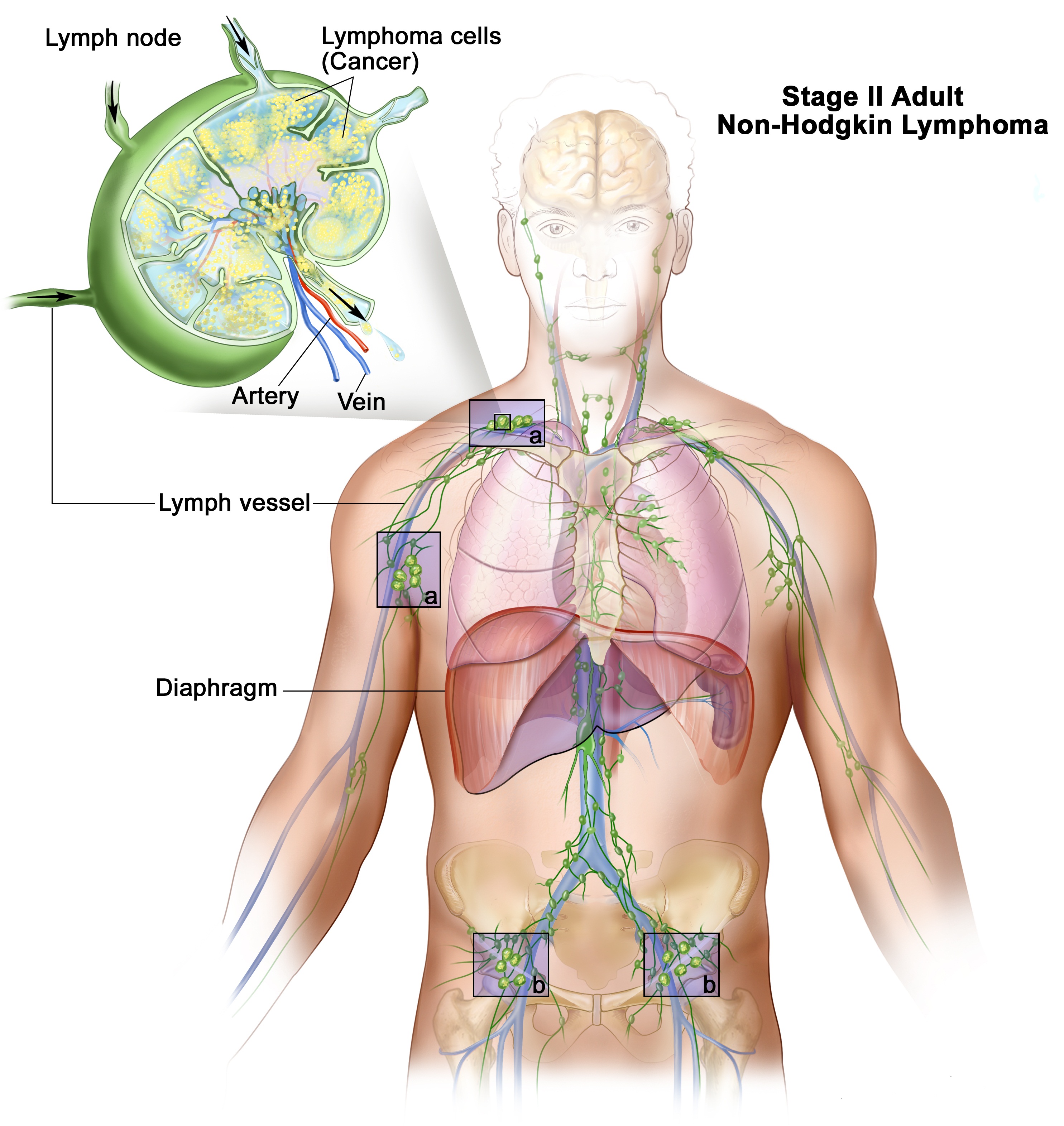Lymphoma - non-Hodgkin's; Lymphocytic lymphoma; Histiocytic lymphoma; Lymphoblastic lymphoma; Cancer - non-Hodgkin's lymphoma
Non-Hodgkin's lymphoma is cancer of the lymphoid tissue, which includes the lymph nodes, spleen, and other organs of the immune system.
Causes, occurrence, and risk factors
White blood cells called lymphocytes are found in lymph tissues. They help prevent infections. Most lymphomas start in a type of white blood cells called B lymphocytes, or B cells.
For most patients, the cause of this cancer is unknown. However, lymphomas may develop in people with weakened immune systems. For example, the risk of lymphoma increases after an organ transplant or in people with HIV infection.
There are many different types of non-Hodgkin's lymphoma. It is classified according to how fast the cancer spreads.
The cancer may be low grade (slow growing), intermediate grade, or high grade (fast growing). Burkitt's tumor is an example of a high-grade lymphoma. Follicular lymphoma is a low-grade lymphoma
The cancer is further sub-classified by how the cells look under the microscope, for example, if there are certain proteins or genetic markers present.
According to the American Cancer Society, a person has a 1 in 50 chance of developing non-Hodgkin's lymphoma. Most of the time, this cancer affects adults. However, children can get some forms of lymphoma. High-risk groups include those who have received an organ transplant or who have a weakened immune system.
This type of cancer is slightly more common in men than in women.
Symptoms
Non-Hodgkin's lymphoma can cause a variety of symptoms. Symptoms depend on what area of the body is affected by the cancer and how fast the cancer is growing.
Symptoms may include:
Night sweats (soaking the bedsheets and pajamas even though the room temperature is not too hot)
Fever and chills that come and go
Itching
Swollen lymph nodes in the neck, underarms, groin, or other areas
Weight loss
Coughing or shortness of breath may occur if the cancer affects the thymus gland or lymph nodes in the chest, which may put pressure on the windpipe (trachea) or other airways.
Some patients may have abdominal pain or swelling, which may lead to a loss of appetite, constipation, nausea, and vomiting.
If the cancer affects cells in the brain, the person may have a headache, concentration problems, personality changes, or seizures.
Cipher and tests
The doctor will perform a physical exam and check body areas with lymph nodes to feel if they are swollen.
The disease may be diagnosed after:
Biopsy of suspected tissue, usually a lymph node biopsy
Bone marrow biopsy
Other tests that may be done include:
Blood test to check protein levels, liver function, kidney function, and uric acid level
Complete blood count (CBC)
CT scans of the chest, abdomen and pelvis
Gallium scan
PET (positron emission tomography) scan
If tests reveal you do cancer, additional tests will be done to see if it has spread. This is called staging. Staging helps guide future treatment and follow-up and gives you some idea of what to expect in the future.
Action - Treatment
Treatment depends on:
The type of lymphoma
The stage of the cancer when you are first diagnosed
Your age and overall health
Symptoms, including weight loss, fever, and night sweats
Radiation therapy may be used for disease that is confined to one body area.
Chemotherapy is the main type of treatment. Most often,multiple different drugs are used in combination together.
Another drug, called rituximab (Rituxan), is often used to treat B-cell non-Hodgkin's lymphoma.
Radioimmunotherapy may be used in some cases. This involves linking a radioactive substance to an antibody that targets the cancerous cells and injecting the substance into the body.
People with lymphoma that returns after treatment or does not respond to treatment may receive high-dose chemotherapy followed by an autologous bone marrow transplant (using stem cells from yourself).
Additional treatments depend on other symptoms. They may include:
Transfusion of blood products, such as platelets or red blood cells
Antibiotics to fight infection, especially if a fever occurs
References
Bierman PJ, Harris N, Armitage JO. Non-Hodgkin’s lymphoma. In: Goldman L, Ausiello D, eds. Cecil Textbook of Medicine. 23rd ed. Philadelphia, Pa: Saunders Elsevier; 2007: Chap 196.
Wilson WH, Armitage JO. Non-Hodgkin’s Lymphoma. In: Abeloff MD, Armitage JO, Niederhuber JE, Kastan MB, McKenna WG, eds. Abeloff’s Clinical Oncology. 4th ed. Philadelphia, Pa: Elsevier Churchill Livingstone; 2008:Chap 112.
National Comprehensive Cancer Network. National Comprehensive Cancer Network Clinical Practice Guidelines in Oncology: Non-Hodgkin’s Lymphomas. 2011. Version 1.2011. [PubMed]



No comments:
Post a Comment